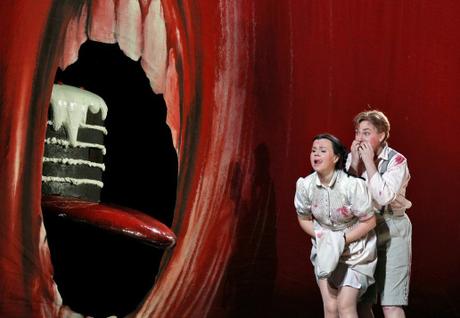 Hansel and Gretel: Having their cake at the Met (classicalsource.com)
Hansel and Gretel: Having their cake at the Met (classicalsource.com)Those Were the Days…
Incorrectly termed a “children’s opera,” Engelbert Humperdinck’s charming yet deceptively simple retelling of Hansel and Gretel, or, in the original German, Hänsel und Gretel, holds a special place in my heart: as a youngster, it was the first opera I ever saw performed live and onstage.
I remember sitting in an auditorium transfixed by the event, unable to take my eyes off the performers or from the colorful sets and flashy costumes. I was completely immersed in the liveliness of it all — the music, the dancing, the sprightly song content, and (for me, anyway) the fantastical “special effects”: the haunted forest, the gingerbread house, the sandman and dew fairy, and of course the evil old witch. I was especially curious to learn how the witch was able to fly through the air with the greatest of ease (she used a harness, darn it).
That was many years ago, back in the giddy days of the New York City public school system in the Bronx, where I lived and studied and grew up. I can’t tell you where, exactly, I saw this wonderful work — that’s too far back for me to recall. Now that I think about it, it might have been a student production at the Bronx High School of Science, located near the Jerome Park Reservoir, and sandwiched between the Kingsbridge and Van Cortlandt Park sections of the city. But don’t ask me to swear on a stack of bibles, because I can’t. All I know is that we were driven by bus to a remote locale and told to take our seats in a large assembly hall of a spot I had never been to before.
In any event, the little production was sung in English, which was a blessing in disguise for us opera initiates. In my day, there were no such modern-day contrivances as supertitles or real-time translations on the back of people’s chairs. Going to and appreciating the opera became an art form in itself that I, for one, took rather seriously. But that was much later in life. At that point in my public school “career,” all I wanted out of the trip was to sit back, relax, and enjoy the program for what it was: entertaining and mirthful.
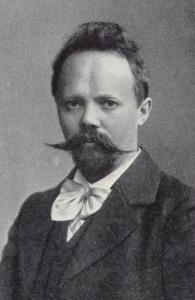
By way of background introduction to Hansel and Gretel, a German composer named Engelbert Humperdinck (no relation to the British pop star) wrote the score between 1890 and 1893, to an original libretto fashioned by his sister, Adelheid Wette, who based this “fairy tale opera” on the Brothers Grimm story.
In adapting the work for a wider audience, Humperdinck removed some of the more ghastly aspects of the plot (i.e., the Mother’s pretext for sending the kids off into the forest was to starve them to death!), while adding the beloved characters of the sandman and dew fairy, along with 14 guardian angels who watch over the pair at night.
Originally, Adelheid had asked her brother Engelbert, a serious musician and follower of Herr Wagner (he had tutored the master’s son, Siegfried, for a time) to provide the musical numbers for a puppet show her children were putting on — a simple little request, right? Well, one thing led to another and within a relatively short time a full-scale operatic vehicle was in the works. Humperdinck expanded the original concept, resulting in a richly flavorful score fit for theatrical consumption.
The first performance of the work was given on December 23, 1893, in Weimar, Germany. It was conducted by composer Richard Strauss (ten years younger than Humperdinck), the heir apparent to the Wagnerian mantle and himself a future guiding beacon as to where German opera would be headed upon Wagner’s demise a decade earlier. We’ll be hearing Strauss’ one-act wonder Elektra in a few weeks, so listeners can judge for themselves whether he earned his stripes or not.
Although Strauss may have done Humperdinck a huge favor in presenting his work in a favorable light, in the long run he quickly overtook Engelbert in the compositional sphere. In truth, Humperdinck is mostly known for this, his earliest stage piece. Recently, the composer’s Königskinder (“The King’s Children”), another fairy-tale opera that came immediately after Hansel and Gretel and made a rousing 1910 debut at the Met, has been revived with a fair amount of success.
‘Tis the Season!
Returning to Humperdinck’s Hansel and Gretel, here’s an example of a work that, although not necessarily related to or even directly involved with the Christmas season, has had an unusually strong association with the Judeo-Christian holiday throughout its performance history. In this country at least, this association comes from its having been the first complete radio broadcast of a lyric work by the Metropolitan Opera Company, on December 25, 1931 — Christmas Day, for all intents and purposes.
That historic broadcast, hosted by announcer Milton Cross and moderated by New York Times critic Olin Downes, would go on to set the standard for what was to become a regular Saturday afternoon gathering of opera lovers from across the country and around the world. Strangely, on that same occasion Hansel and Gretel was paired with Leoncavallo’s highly dramatic opus, Pagliacci. The Leoncavallo work was not transmitted, which represents a lost opportunity, for the cast included such Met Opera stalwarts as Giovanni Martinelli and Giuseppe De Luca. For shame!
However we may sigh over that omission, Hansel and Gretel (sung in German at this juncture) featured sopranos Editha Fleischer and Queena Mario in the title roles, dramatic soprano Dorothée Manski as the Witch, baritone Gustav Schützendorff as Peter the Father, and mezzo-soprano Henriette Wakefield as Gertrude the Mother. The conductor was Karl Riedel. From the newspaper clippings of this and an earlier test broadcast, composer and well-known personality Deems Taylor provided a running commentary. Animated film fans may remember Mr. Taylor as the narrator and host of Walt Disney’s Fantasia from 1940.
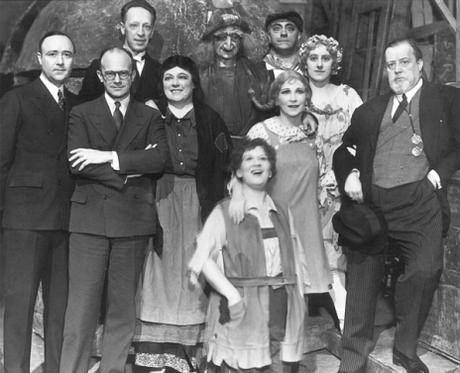
Many positive telegrams and letters were received by the Met management praising the company for its efforts. However, an equal number of correspondents protested the presence of Taylor’s voice during the live performance. One listener famously wrote: “Is it possible to have Mr. Taylor punctuate his speech with brilliant flashes of silence?” According to TIME magazine, in later broadcasts, “Narrator Taylor was less garrulous.” How fortunate for all!
Where Would We Be Without Our Tradition?
In the past, traditional productions of Hansel and Gretel adhered to a mezzo or dramatic soprano Witch, with the requisite broomstick, warty nose, and pointy hat. Most up-to-date interpretations, however, employed the services of a character tenor in the part — to good effect, it must be maintained. Some memorable men in drag who gave life to Rosina Dainty-Lips were Paul Franke, Andrea Velis, Charles Anthony, Graham Clarke, and Philip Langridge.
The enjoyable Met Opera version by producer Nathaniel Merrill and set designer Robert O’Hearn, which served the company well for nearly 45 years, boasted a bass-baritone, the German-born Karl Dönch, as the Witch at its premiere on November 6, 1967. In addition, the casting of major roles was spot-on perfect, with Rosalind Elias and Teresa Stratas endearing as the brother and sister act. Later casts included the teaming of Frederica von Stade with Judith Blegen, and Tatiana Troyanos with Catherine Malfitano. They all made handsome Hansels and girlish Gretels to charm the pants (er, dress) off any Witch, male or otherwise.
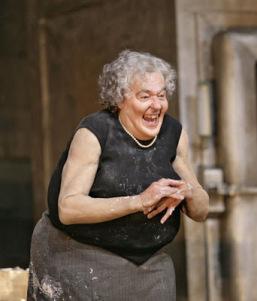
The Met’s current Richard Jones adaptation, first unveiled in December 2007 and formerly mounted at Welsh National Opera, updates and modifies the story to the 1950s. In the process of transformation, it created some incredibly imaginative, surrealistic stage pictures, at times in opposition to the text. Not to fear: the superlative new English translation (by librettist David Pountney) lends a wicked touch of darkness to the piece. The new cast starred Alice Coote as Hansel and Christine Schäfer as Gretel, with the aforementioned Mr. Langridge as the Witch, Alan Held as Peter, Rosalind Plowright as Gertrude, and conductor Vladimir Jurowski on the podium.
One thing this production got right was to reintroduce those presumably lurid moments, such as the children’s punishment for refusing to do their chores and the sibling’s well-timed “execution” of the Witch by burning her alive in the oven. In line with the above incidents, some of the childhood themes this version explored include self-medication, the excesses of over-indulging one’s appetite for baked goods, and the escalating effect of poverty on one’s mental capacities. As you can see, this was not just a simple bedtime story but a lesson in hazardous living.
Other outlandish details — for example, the drop-curtain of a large plate with knife and fork, which converts to a gaping tooth-filled mouth with a protruding pink tongue at the start of Act II — will surely remind viewers of the moral to the Grimm Brothers’ dark tale: “Be resourceful, face your fears, have courage in the face of difficulties.” It can also inform us to be kind to our mommies and daddies, or bad things can happen to those who disobey. Huh, I’ll say they can!
Another innovation was the bizarrely sumptuous Dream Pantomime sequence in which a fish-headed maître d’ served up an extensive banquet of gastronomic treats, escorted by a team of giant-sized cooks resembling the iconic Chef Boyardee whose face was omnipresent on American cans of ravioli. Well, then, if tenors and baritones can transform themselves into witches, why not make guardian angels into chefs?
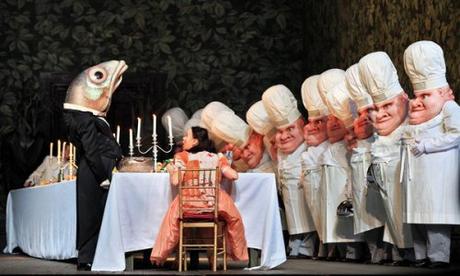
Much has changed since I first saw this piece in the Bronx. But there’s one thing I won’t forget, and that is Gretel’s cheery little song to calm her mischievous brother:
With my foot I tap, tap, tap
With my hands I clap, clap, clap
One by here, one by there
Round you go without a care
(English Translation: Lewis Reynolds)
Copyright © 2016 by Josmar F. Lopes

